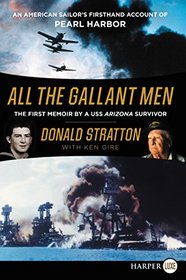There is not a lot I can add to this review which isn't stated in the book's description above. Imagine having to pull yourself, for many yards, hand-over-hand on a rope when you have severe burns over most of your body and most of the flesh on one of your hands is missing. Then having to endure constant pain, not for days or weeks, but for months. Stratton never gave up hope and was determined to survive. Then a year after he was discharged medically from the service he re-enlisted to serve again on a destroyer in several campaigns.
Stratton devotes a chapter to the decision on dropping the atomic bomb, and he defends it. Millions of men who survived World War II knew they survived it due to the use of the atomic bomb. Those who don't believe this should read books on the subject. In addition, the atomic bomb saved the Japanese nation. In addition to the million plus casualties the Allies would have suffered invading Japan, the Japanese military was encouraging the Japanese people to all die in the final struggle. And as Stratton himself states in the book, while the U.S. dropped millions of leaflets encouraging civilians to leave cities marked for bombing, no Japanese leaflets were dropped on Pearl Harbor before the sneak attack.
The only problem I found with the book is Stratton's description of the guns on the Arizona on page 48---and on page 65 where he describes its antiaircraft guns as being .22 caliber. Even at that time, a .22 caliber gun wouldn't have brought down a piper cub. On page 48, he lists "...three .45 caliber 14-inch guns...twenty-two .51 caliber, 5-inch antiaircraft guns and four .50 caliber, 3-inch guns." This would be like describing a frying pan as being a "7-inch, 35-inch" pan. Except the difference is much larger, as a 14-inch gun is a bit over 29 times bigger in diameter than a .45 caliber gun. Of course, he was in his 90s when making this mistake so I'll forgive him. Especially when I often successfully guess the correct word in Wordle and then 30 minutes later can't remember what it was. And I'll only be 75 next month. Still, how the editors at the publisher let this get past them is inexcusable.
Stratton devotes a chapter to the decision on dropping the atomic bomb, and he defends it. Millions of men who survived World War II knew they survived it due to the use of the atomic bomb. Those who don't believe this should read books on the subject. In addition, the atomic bomb saved the Japanese nation. In addition to the million plus casualties the Allies would have suffered invading Japan, the Japanese military was encouraging the Japanese people to all die in the final struggle. And as Stratton himself states in the book, while the U.S. dropped millions of leaflets encouraging civilians to leave cities marked for bombing, no Japanese leaflets were dropped on Pearl Harbor before the sneak attack.
The only problem I found with the book is Stratton's description of the guns on the Arizona on page 48---and on page 65 where he describes its antiaircraft guns as being .22 caliber. Even at that time, a .22 caliber gun wouldn't have brought down a piper cub. On page 48, he lists "...three .45 caliber 14-inch guns...twenty-two .51 caliber, 5-inch antiaircraft guns and four .50 caliber, 3-inch guns." This would be like describing a frying pan as being a "7-inch, 35-inch" pan. Except the difference is much larger, as a 14-inch gun is a bit over 29 times bigger in diameter than a .45 caliber gun. Of course, he was in his 90s when making this mistake so I'll forgive him. Especially when I often successfully guess the correct word in Wordle and then 30 minutes later can't remember what it was. And I'll only be 75 next month. Still, how the editors at the publisher let this get past them is inexcusable.




